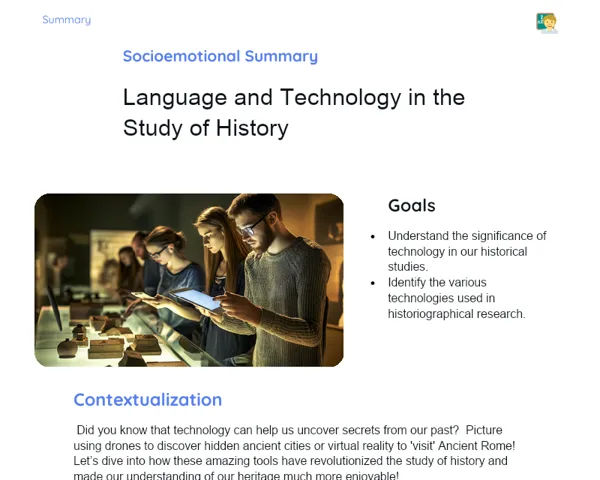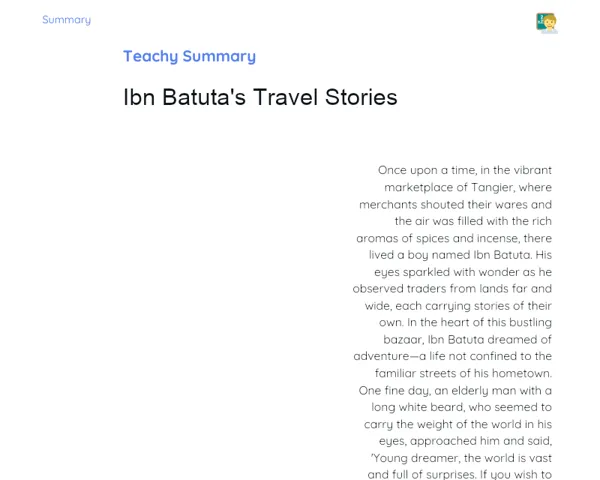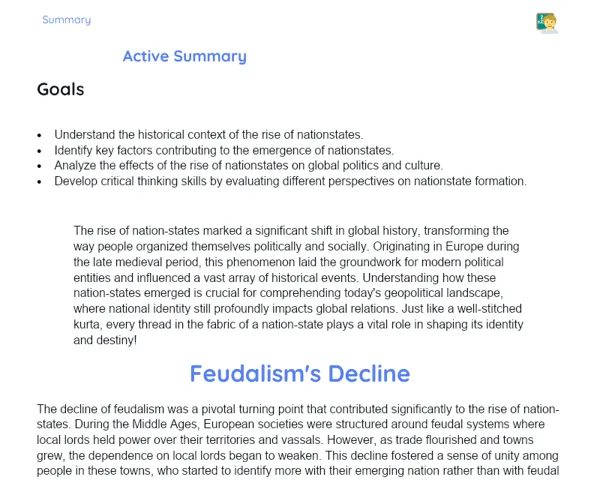Summary Tradisional | Study of History: Introduction
Contextualization
History is a branch of knowledge that examines human actions throughout time. Contrary to common belief, it's not merely a collection of dates and events; it requires a thorough analysis of the contexts, decisions, and ramifications that have influenced our journey as a society. By delving into the past, historians aim to comprehend how human actions and significant historical occurrences have impacted the evolution of our modern communities.
Studying history is essential for grasping the present and forecasting the future. Being aware of pivotal events allows us to identify patterns and learn from the triumphs and mistakes of our predecessors. For example, events like the French Revolution and India’s struggle for independence highlight how such occurrences were key in shaping ideas around democracy and self-rule, which continue to resonate in contemporary political and social landscapes. Thus, history equips us with valuable insights to foster a just and enlightened society.
To Remember!
What is History?
History is a branch of knowledge devoted to studying human actions over time. It is not just a list of dates and occurrences; it involves a detailed analysis of contexts, decisions, and impacts that have shaped our society. By exploring the past, historians strive to understand the effects of human interaction and historical events on the development of contemporary societies.
Grasping history is vital for understanding our present circumstances and mapping out future plans. Recognizing significant historical moments helps us discern patterns and learn from past experiences, both good and bad. For instance, by studying the French Revolution or India's Independence, we notice their crucial role in forming democratic ideals and principles of sovereignty, which shape current political and social frameworks. Therefore, history gives us the tools to create a more equitable and informed society.
-
History is the science that explores human actions over time.
-
It goes beyond merely recording dates and occurrences to include context and decisions.
-
Understanding history is essential for comprehending the present and preparing for the future.
Historical Sources
Historical sources are the materials historians utilize to investigate the past. They can be categorized into two principal groups: primary and secondary sources. Primary sources are original documents or objects that were created during the time being studied, such as letters, diaries, official papers, archaeological finds, and photographs. These sources offer direct evidence about the era and location in question.
Conversely, secondary sources are analyses, interpretations, or summaries of historical events crafted after the time in focus. Examples include history books, scholarly articles, and documentaries. These secondary sources are crucial for understanding the diverse perspectives and interpretations that historians express regarding past events.
Critically analyzing historical sources is essential to maintain the accuracy and credibility of the information. Historians need to consider the context in which these sources were created, along with potential biases and limitations. This thorough analysis enables a more rounded and nuanced view of history.
-
Historical sources can be primary (created during the studied period) or secondary (later interpretations).
-
Primary sources include documents, letters, diaries, and archaeological artifacts.
-
Secondary sources consist of history books, scholarly articles, and films.
-
A critical analysis of sources is essential for ensuring accuracy and dependability.
Historiography
Historiography is the exploration of how history is recorded and the methods employed by historians. It focuses on examining how historians interpret and document past events, alongside the diverse theoretical and methodological approaches adopted throughout history. This field illustrates that history is not a singular, unchanging narrative but rather a construct that can differ based on a historian’s perspective and contextual backdrop.
Various historiographical schools, including Marxism, positivism, and cultural history, provide different interpretations of the same historical occurrences. For instance, the French Revolution can be analyzed through multiple lenses: as a struggle between social classes, a quest for liberty and equality, or a series of cultural and societal shifts. These varied viewpoints enhance our comprehension of history and present a multifaceted understanding of past events.
Historiography also illustrates how interpretations of history can evolve over time with the introduction of new research methods and the discovery of new resources. It encourages critical thought and urges us to question established narratives, recognizing that history is a field that is continuously growing and changing.
-
Historiography involves the exploration of historical writing and the techniques of historians.
-
It encapsulates various theoretical and methodological frameworks.
-
It reveals that historical narratives can vary based on the historian's perspective.
-
Historical interpretations can transform with new research methods and findings.
Memory and Culture
Memory and culture are integral concepts for grasping history, as they shape how events are remembered and understood. Collective memory refers to the shared memories and narratives of a group or community that mold their identity and collective views of the past. This idea emphasizes that history is not simply an impartial record of facts but also a social construct that reveals specific values, beliefs, and interests.
Culture embodies the practices, traditions, symbols, and artistic expressions of a society. It significantly influences how historical events are commemorated and represented. For instance, national holidays, monuments, and ceremonies are all expressions that help solidify and communicate the shared memory of important occurrences. These cultural representations forge connections to the past and transmit values and teachings to future generations.
Acknowledging that distinct cultures may hold different interpretations of the same historical events is vital. The manner in which events are commemorated and understood can vary markedly across various social and cultural factions. This diversity of perspectives enriches our historical comprehension and promotes consideration of multiple viewpoints when analyzing the past.
-
Collective memory signifies shared memories and narratives within a society.
-
Culture encompasses practices, traditions, and symbols that shape the representation of historical events.
-
Various cultures might interpret the same historical events differently.
-
Cultural expressions (such as holidays and monuments) help communicate collective memory.
Key Terms
-
History as a branch of knowledge: Study of human actions across time.
-
Primary historical sources: Documents or objects created during the studied period.
-
Secondary historical sources: Analyses or summaries crafted after the studied period.
-
Historiography: Exploration of historical writing and methodologies.
-
Collective memory: Compilation of shared memories and narratives within a society.
-
Culture: Practices, traditions, and symbols of a society.
-
French Revolution: Major historical event that shaped concepts of democracy and self-governance.
-
India's Independence: Significant historical event that influenced the formation of the country's political and social landscape.
Important Conclusions
In this lesson, we explored the definition of history as a branch of knowledge, emphasizing its essential role in examining human actions over time. We established that history extends beyond a mere collection of dates and events, requiring an in-depth analysis of the contexts and decisions that have guided humanity. Examples such as the French Revolution and India's Independence illustrated how historical events exert a direct influence on the present.
We also discussed the concept of historical sources, distinguishing between primary and secondary types, and highlighted the importance of critically analyzing these sources to maintain the integrity and reliability of the information. We examined historiography and learned how diverse methodologies and perspectives can yield different interpretations of the same events, thereby enriching our understanding of history.
Finally, we looked into the relationship between collective memory and culture in shaping how history is remembered and understood. We acknowledged that various cultures may offer distinct narratives for the same events. Thus, studying history is vital not only for understanding the present and envisioning the future but also for cultivating a collective identity and appreciating the multitude of perspectives contributing to our comprehension of the past.
Study Tips
-
Review your class notes and organize the main concepts discussed, including historical sources, historiography, and collective memory into mind maps or charts.
-
Read recommended literature and scholarly articles on significant historical events like the French Revolution and India's Independence to deepen your knowledge and explore differing perspectives.
-
Engage in study groups or online platforms to converse about historical interpretations with peers and share additional sources and materials that can enhance your comprehension of the subject.



